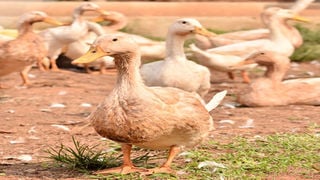
Ducks. PHOTO/FILE
|Farming
Prime
Making duck farming profitable
What you need to know:
- Duck meat is a high-value niche product in Uganda rich in fat, protein and iron.
- Luweero-based farmer Carol Zawedde Sanyu of MLinza Farm, a family-owned enterprise in Wabitungulu, Ziroobwe, Luweero District keeps free-range ducks as a low-risk enterprise.
Carol Zawedde raises free-range Pekin ducks for meat on her 15-acre smallholding, MLinza Mixed Farm located in Wabitungulu, Ziroobwe in Luweero District.
Her duck production enterprise started with only 20 Pekin ducklings back in 2019. She now farms more than 500 ducks at a time.
As and when she gets orders, mature ducks are slaughtered especially those that have attained about two or three kilogrammes each. She then personally delivers the carcasses to customers or they are eaten at the farm during meat tasting sessions.
ALSO READ: My blueprint to reap from poultry this year
Zawedde says she went into duck farming because she wanted a high-turnover enterprise to supplement her goat business. The family made a decision to transfer goats to Kiruhura District as an expansion measure.
“Our research identified that there was a niche for Pekin ducks and broiler chickens, particularly among high-end restaurants and hotels. We now produce both these poultry meat types on our farm,” Zawedde says. As a farmer, she supports ethical and humane farming as well as organic practices.
Raising ducks
There are a number of duck varieties that can be raised on the farm including geese, Indian runners which resemble penguins, the green-feathered Cayuga and dark-plumaged Muscovy. But she prefers the hardy Pekins.
ALSO READ: Keeping ducks for bigger returns
She explains that hatching your own ducklings pays because you are sure of the breed.
At her farm, she keeps ducks at a ratio of one drake (male duck) to three females to get more fertilised eggs. She says that having the hatchery on the farm is important to avoid moving eggs long distances which can result in temperature fluctuation.
Most hatching problems with duck eggs can be attributed to old eggs with low fertility, poor handling, and eggs stored at an irregular temperature. Fertile eggs will stay viable for about seven days after being laid, after which fertility starts to decline. Zawedde explains that day-old ducklings spend their first two weeks in the brooding enclosure whose floor can be covered with wood shavings. While here, she says, they are fed broiler starter placed near water sources.
ALSO READ: Duck meat taking over Ugandan dining tables
For the first three days, she says that it is ideal to add glucose to each water container to provide the ducklings with added vitality. She says that afterwards, the water drinkers are adjusted to keep ducklings away from playing in and muddying the drinking water with possible contaminants. After about three weeks, the ducklings are strong enough and can be allowed to move on the compound. She says that when ducklings go out, they must be taught where the sloping sections are so they can get out safely.
This is because their feathers at this age are not fully waterproof and if a duckling cannot get out, it will drown. At this stage, the ducklings are fed on broiler finisher feeds until they reach the slaughter age. However, Zawedde says that ducklings are heavy consumers averaging 300g each bird a day.
Diseases
Zawedde says that by experience, ducks are the easiest animals to keep if you have water and food. “They rarely get sick so there is no need for vaccination but you have to maintain a high level of hygiene,” she says.
Predators
In a free range system, there are predators such as wild cats. At her farm, the dogs chase most of them away. She encourages farmers to enhance security using wire-mesh fencing surrounding the property where the ducks are kept. Zawedde adds that farm workers should be encouraged to look out for weak points along the perimeter fence because some predators are stealth.
Profitability
Zawedde, a zealous farmer, who uses social media for advertising, has built her client base on word-of-mouth referrals.
But she admits that raising ducks to slaughter age and weight is not a cheap undertaking.
While she is not prepared to divulge the economics of her duck enterprise, she explains that some of the higher production costs include day-old ducklings at about Shs15,000 each; brooding expenses; slaughtering; and the high feed costs.



